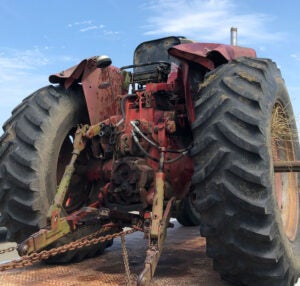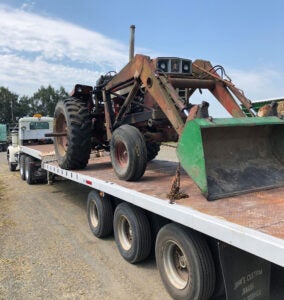Older tractors may be cheaper to buy and easier to fix, but are they safe?
While manufacturers have greatly improved tractor safety since the 1980s, tractors built before then are still widely used without the safety features that newer ones have. In addition to having decades of wear and tear that impact drivability and safety, older tractors typically have a higher center of gravity that makes them especially prone to rollovers. What’s worse is that older tractors, particularly those made before 1977, were not sold new with Rollover Protective Structures (ROPS) and seat belts.
Even though ROPS retrofit kits have been available for years, many farmers continue to risk their lives by using older tractors without them.
Rolling a tractor without ROPS and a seatbelt is sure to end in serious injury or death. In fact, tractor rollovers are the leading cause of fatal injuries on farms. According to the Great Plains Center for Agricultural Health, tractor rollovers result in an average of about 130 deaths each year, and seven out of 10 farms go out of business within five years of a rollover fatality.
Among farmers who survive a rollover, one in seven is permanently disabled. Let’s remember that these sobering statistics represent people who were co-workers, family members, and friends.
A family farmer’s life cut short
The Washington State Fatality Assessment and Control Evaluation (WA FACE) program at the Washington State Department of Labor & Industries has investigated several fatal tractor rollovers. In the 10 years between 2013 and 2022, 18 Washington farmers or farmworkers died in tractor incidents. Two-thirds died in tractor rollovers. Many were operating tractors without ROPS.
In one instance, a 56-year-old family dairy farmer died when his tractor rolled down an embankment. He was operating a tractor built in 1971 that did not have ROPS or a seat belt. The farmer began using it two days earlier when his primary tractor broke down.

The farmer was using the old tractor to tow a 25-plus-foot lagoon pump trailer around the farm’s manure pond to agitate water and cow waste stored in the pond. The mixture was also being pumped out of the pond as soil fertilizer through discharge pipes to an irrigation gun in nearby feed crop fields. To reach the pumping locations, the farmer had to drive the tractor on a narrow dirt track road on top of an earthen embankment that surrounded the pond. It was a slow process due to the difficulty of repositioning the tractor, trailer, and pipes.
It was two hours before sunrise, and the only light at the pond was from the tractor and nearby farm buildings. The farmer was driving the tractor close to the outer edge of the embankment road. The road had no reflective warning signs or markers.
As he turned the tractor sharply near its final stop, its front left wheel got caught in a rut that caused the tractor to roll off the road down a steep slope. The farmer fell to the ground, and the tractor’s 3-point hitch fatally pinned him on his back. His wife and son found him later that morning.
The farmer’s father, who owned the farm, called 911 and used another tractor to lift the rolled vehicle off his son’s body so the coroner could take it.

Investigators found that the farmer’s father bought the tractor at an auction the previous year to train the farmer’s teenage son. When the tractor was new, ROPS was optional from the manufacturer. Although aftermarket certified ROPS and seat belts were available for purchase, they were never retrofitted on the tractor. The farm also did not have an accident prevention program or tractor safety training.
Tips to live by
Making older tractors and work areas safer is the best way to prevent rollover fatalities and injuries. The tips below are a few ways farmers can protect tractor operators from rollover hazards.
- Install only ROPS and seat belts certified by original equipment manufacturers (OEM) and aftermarket manufacturers on tractors. A ROPS system consists of specially designed metal roll bars, frames, and crush proof cabs that typically limit the rollover to around 90 degrees and protect the operator’s body. Using ROPS is 99 percent effective in preventing serious injury and death when used with a seat belt. Without a seat belt, the tractor or ROPS is more likely to crush the operator during a rollover. The seat belt should be tight enough to keep the operator within the ROPS protection zone. ROPS must be installed according to OSHA requirements. Never use a tractor that can’t be retrofitted with ROPS, and do not make your own ROPS. Contact the tractor manufacturer or a farm equipment dealer to arrange professional installation that will ensure proper attachment and durability. Use the National ROPS Rebate Program’s Dealer Locator or Kentucky ROPS Guide to help locate manufacturers and dealers of certified OEM and aftermarket ROPS retrofitting kits. In some states where rebate funding is available, the National ROPS Rebate Program may be able to assist with the cost of retrofitting your tractor.
- Develop a tractor safety training program that includes the proper use of ROPS and seat belts as part of your accident prevention program. Train all operators regardless of expertise level, as 80 percent of rollover deaths involve experienced operators. Farmers can bolster their training program by having tractor operators attend farm machinery safety workshops and trainings, such as AgSafety4U. Provide refresher training when new tractors are introduced, unsafe behaviors are observed, and when requested by operators. Keep and review training records to ensure operators are up to date in their training.
- Keep tractor operating areas safe. Routinely inspect, repair, and maintain driving surfaces to ensure they stay smooth, even, and stable. Make sure roads are wide enough to keep tractors from driving too close to edges and slopes. Provide sufficient lighting in areas where tractors operate during hours of darkness. Tractor operators should be able to easily see machine controls and roads. Post warning signs on roads that remind operators to drive slowly and alert them of turns, corners, bumps, slopes, and crossing points. Install reflective stakes along roads to help keep tractors away from edges and slopes. Operators should also work with a trained spotter when maneuvering equipment near blind spots.
As each farm and tractor are different, farmers should consider what they could do individually to improve tractor safety on their farm. Let’s honor farmworkers and their families by rededicating ourselves to doing everything possible to keep them safe from harm.
This article was written by Paul Karolczyk and Randy Clark, FACE research investigators, and Todd Schoonover, FACE program director. Sign up here to receive WA FACE agriculture fatality and injury investigation reports, hazard alerts, data summaries, and shorter form narratives and slideshows.


